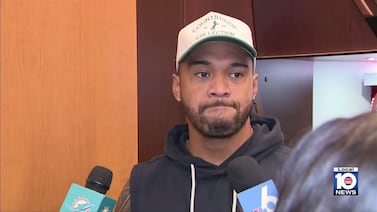DAVIE, Fla. — It may look green and lush, but among the 23 acres of the Pine Island Ridge in Tree Tops Park, there’s an invasion taking place. Plants and trees that shouldn’t be there are multiplying and taking over.
“Here you have a perfect example,” Anthony Gross, project manager of NatureScape Broward, pointed out. “You have Australian pine and you’ve actually got some Melaleuca right there behind it.”
They’re two of Florida’s most invasive trees that spread like wildfire and threaten to drastically and permanently change our native ecosystems.
“We see the damage, we see results, but we don’t have large-scale management of them,” Gross explained.
It’s a big problem throughout South Florida, with even imported house plants wreaking havoc.
“This is a perfect example of the snake plant that’s so hard to remove,” said Gross as he pointed to a plot of sprawling snake plants within Tree Tops Park. “And when you do, you see, when it comes out, it breaks, so then the roots are still there and it comes back up.”
Sansevieria, also known as the snake plant, has become a popular houseplant in recent years as consumers seek low-maintenance air-purifying plants for their homes. But while it may be a solid choice for an indoor plant, Gross advises that they should stay inside.
“That’s one of our top invasives in our natural areas, and our parks here in Broward County, so much so that we actually have a snake plant StrikeForce that actually goes and go on weekends to eco-friendly days, or environment days in our parks, just to remove them,” Gross explained.
These invasives didn’t just pop out of thin air, the problem is us.
“Humans are the biggest culprit,” Gross pointed out. “What’s popular and what looks current and modern, sometimes is actually devastating in our environment. We want to make sure that we don’t put something that’s going to escape our backyards and move into our natural areas, our parks,” he explained. “[Here] we could identify at least 10 to 15 plants that are really should be a house plant or a pot plant in the person’s backyard and they’ve escaped.”
NatureScape Broward is a program that teaches residents how to plant “Florida-friendly” landscapes to claim back what Mother Nature intended.
“The beauty of a native plant is generally when you plant it, it takes three to six months to establish so you do water during that time frame,” Gross said. “But once it’s established, you don’t need to water any longer.”
That’s because native plants are naturally adapted to our climate, our soils, and our wildlife. They don’t need fertilizers or pesticides. And with climate change turning up the heat, they can help build up our tree canopy and provide much-needed shade for our homes and communities.
“We have residences that have old oak tree canopies that reduce the temperature so much within the backyards that the homeowners might only have $100 average home electricity bill,” remarked Gross. “One (tip) is also mulching and to make sure that you mulch your plants in your garden beds. And by doing so you’re actually reducing the evaporation of water from that.”
Another tip from NatureScape is to replace lawn cover with native plants that provide ground cover like the Frogfruit.
“Most people are not aware that you could spend over 60% of your water bill each month just on irrigating your turf,” said Gross.
Coconut Creek resident Ramona “Mona” Johnston reaps the benefits of planting native.
“It’s my happy place. It’s my church if you will,” Johnston remarked as she marveled at her backyard. “And it’s been about a 25-year project.”
Her backyard is nearly all indigenous.
“We call it the little Everglades because that’s exactly what it is,” she said. “This is no longer the real Everglades…but this is as close as we can come in an urban garden setting to what would have gone on naturally in the environment.”
Johnston was recognized during this year’s Water Matters Day as a “Naturescape Legacy Winner” for her commitment to growing back old Florida.
“This entire slant here is another one of our native orchids that are threatened and endangered,” she explained as she pointed to an area in her yard.
She’s also encouraged six of her neighbors to follow in her mission. Together they’ve created a continuous wildlife corridor, right in the heart of their neighborhood.
“We have lost so much because of habitat loss,” Johnston reflected. “And habitat loss means not just clearing…but not replanting the proper things.”
NatureScape is hoping to engage more owners to landscape more consciously with incentives like the giveaway at this year’s Water Matters Day where over 2-thousand plants were gifted to the community. After all, this is our shared backyard and it’s up to all of us to make sure it continues to thrive.
“There’s a lot of information out there,” Johnston said. “It’s not hard work, but you do have to be mindful.”
To learn about how you can certify your landscape as a NatureScape, visit the NatureScape website. You can also find a full list of Florida Native Plants on the University of Florida IFAS Extension Gardening Solutions page.
Copyright 2024 by WPLG Local10.com - All rights reserved.


